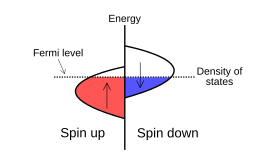
Quick Facts
Biography
Edmund Clifton Stoner FRS (2 October 1899 – 27 December 1968) was a British theoretical physicist. He is principally known for his work on the origin and nature of itinerant ferromagnetism (the type of ferromagnetic behavior associated with pure transition metals like cobalt, nickel, and iron), including the collective electron theory of ferromagnetism and the Stoner criterion for ferromagnetism.
Biography
Stoner was born in Esher, Surrey, the son of cricketer Arthur Hallett Stoner. He won a scholarship to Bolton School (1911–1918) and then attended University of Cambridge in 1918, graduating in 1921. After graduation, he worked at the Cavendish Laboratory on the absorption of X-rays by matter and electron energy levels; his 1924 paper on this subject prefigured the Pauli exclusion principle. Stoner was appointed a Lecturer in the Department of Physics at the University of Leeds in 1932, becoming Professor of Theoretical Physics there in 1939. He did some early work in astrophysics and computed a limit for the mass of white dwarf stars in 1930. Most of his research, however, was on magnetism, where, starting in 1938, he developed the collective electron theory of ferromagnetism. He retired in 1963.
He is also known for his discovery of the Chandrasekhar limit before S. Chandrasekhar.
Awards
The E C Stoner building at the University of Leeds is named after him.,
He was elected a Fellow of the Royal Society in May 1937.
Stoner had been diagnosed with diabetes in 1919. He controlled it with diet until 1927, when insulin treatment became available.
Stoner model of ferromagnetism

Electron bands can spontaneously split into up and down spins. This happens if the relative gain in exchange interaction (the interaction of electrons via the Pauli exclusion principle) is larger than the loss in kinetic energy.
where is the energy of the metal before exchange effects are included, and are the energies of the spin up and down electron bands respectively. The Stoner parameter which is a measure of the strength of the exchange correlation is denoted , the number of electrons is . Finally is the wavenumber as the electrons bands are in wavenumber-space. If more electrons favour one of the states this will create magnetism. The electrons obey Fermi–Dirac statistics so when the above formulas are summed over all -space then the Stoner criterion for ferromagnetism can be established.
Selected publications
- The distribution of electrons among atomic levels, Philosophical Magazine (6th series) 48 (1924), pp. 719–736.
- The limiting density of white dwarf stars, Philosophical Magazine (7th series) 7 (1929), pp. 63–70.
- The equilibrium of dense stars, Philosophical Magazine (7th series) 9 (1930), pp. 944–963.
- Magnetism and atomic structure, London: Methuen, 1926.
- Magnetism and matter, London: Methuen, 1934.
- Collective electron ferromagnetism in metals and alloys, Journal de physique et le radium (8th series) 12 (1951), pp. 372–388.








